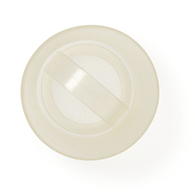Cervical cap: Basic Info

The cervical cap is a reusable silicone cup you fill with spermicide and insert deep into your vagina before penis-in-vagina sex. The cervical cap covers your cervix and keeps sperm from entering your uterus and fertilizing an egg. The spermicide you use with it makes sperm less able to move. FemCap is the only brand of cervical cap available in the U.S. today.
The cervical cap looks like a little sailor's hat, with a wide, upturned brim. There are three different sizes of FemCap, and a provider will figure out which size you need, which is based on whether you've been pregnant before and how that pregnancy (or pregnancies) ended. You don't have to see a provider in person to get the FemCap, but you do need a prescription for it.
One super important thing to remember is that for the cervical cap to work correctly to prevent pregnancy, you need to use it with spermicide.
The cervical cap is similar in a lot of ways to the diaphragm, another barrier method that you use with spermicide. But the two are different in a few ways. The cervical cap has a removal strap that makes it easier to take it out, whereas the diaphragm has a small removal dome to help you take it out. You can also leave the cervical cap in for 48 hours, while you can only leave the diaphragm in for 24 hours. Finally, the diaphragm is more effective at preventing pregnancy than the cervical cap if you've ever had a full-term vaginal birth.
Quick Facts
Pretty effective if you use it correctly. Can be put in hours before having sex and doesn’t affect your hormones.
- Effectiveness
The cervical cap is pretty effective the way most people use it. It’s more effective when used with spermicide.
Perfect Use: Not enough data% effective.
Typical Use: 71% to 86% effective.
- Hormones
The cervical cap is hormone-free.
- Side effects
Irritation or discomfort are possible.
- Cost
Pay once for fitting ($0-$200) and the cap ($0-$89); ongoing cost for spermicide of around $1 per dose.
- STI protection
The cervical cap doesn’t protect against STIs.
- Ongoing effort
You have to put it in place every time you’re going to have sex.


